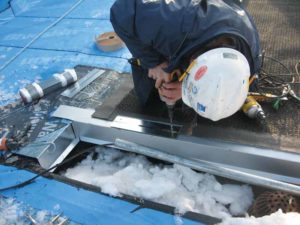The challenges of winter roofing
Weather

Understanding the weather conditions at the place of the work is critical in deciding when to start or temporarily stop roofing operations. It can be a bit of a costly guessing game. During the winter, design/construction professionals are faced with prolonged periods of rain, extreme cold, wet snow, ice, and cold winds, which can pose a significant challenge to the project schedule and budget, as well as the patience of all parties.
Product manufacturers typically require underlying surfaces to be free of debris and moisture (e.g. water, frost, snow, and ice). Who takes care of snow and ice removal prior to and during construction activities is a critical decision. Contractors must be allowed to properly carry additional costs if this work is to be done by their forces. If snow removal is to be completed by the owner’s team, this poses additional challenges, as the owner may be deemed the constructor of the project, meaning responsibility for site safety shifts from the contractor to the owner.
Contractors may dispose of a light amount of snow by either sweeping or shovelling it away from the work area. If the building is noncombustible, they may decide to use an open-flame torch to melt the snow/ice and dry the roof. Cleaning snow off a concrete deck is relatively easy, as it is just like shovelling the driveway, but on a steel deck, the contractor has to clean the lower flutes, which is an extremely tedious and time-consuming task that may take several hours to complete. Further, quality and durability issues can surface with the roof system if the substrates are not adequately dried. For example, blisters may form or adhesion could be compromised.
Snow removal is as expensive as it is labour intensive. It can take three or four roofers out of a typical six-person crew to undertake this task, and more if the snowfall is heavy. If the requirements for snow management are not factored into the contract documents, then the owner will likely be exposed to additional charges for snow removal.
In these authors’ experience, the typical labour costs of a unionized roofing crew of six (within a 100-km [60-mi] radius of home base) is in the range of $5000 to $6000 per day. Therefore, the question becomes, “Should the roofing crew remove some snow to do a little bit of roofing only to repeat the work a few days later, after it snows again?”
This is a difficult decision to make. For example, if there is only a day or two left to complete the project, the team may consider spending this amount and finishing the work. Alternatively, if the team is about to start a new section, the work may be halted until the weather improves. Finally, depending on the project delivery schedule, operating requirements, and budgeting limitations, the team may be forced to take the least palatable option, which is to accept the risks and work through the winter.
Roofing work could also impact mechanical systems, which may need to be temporarily turned off to avoid drawing in odours and dust. Having the heating system down during below-freezing temperatures will have a definite impact on occupant comfort. Usually, sequencing the downtime of units will be required or temporary heat may be necessary to maintain interior comfort for tenants.
These considerations must be made in the early stages of the project so adequate planning can be incorporated into the design.


